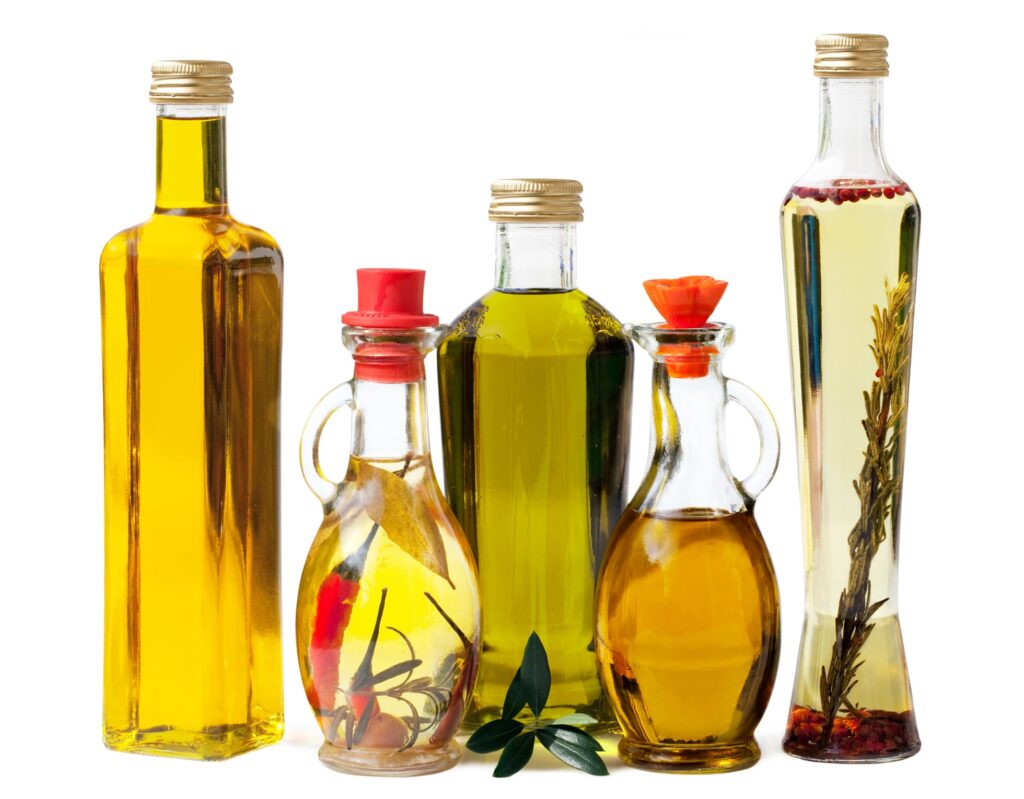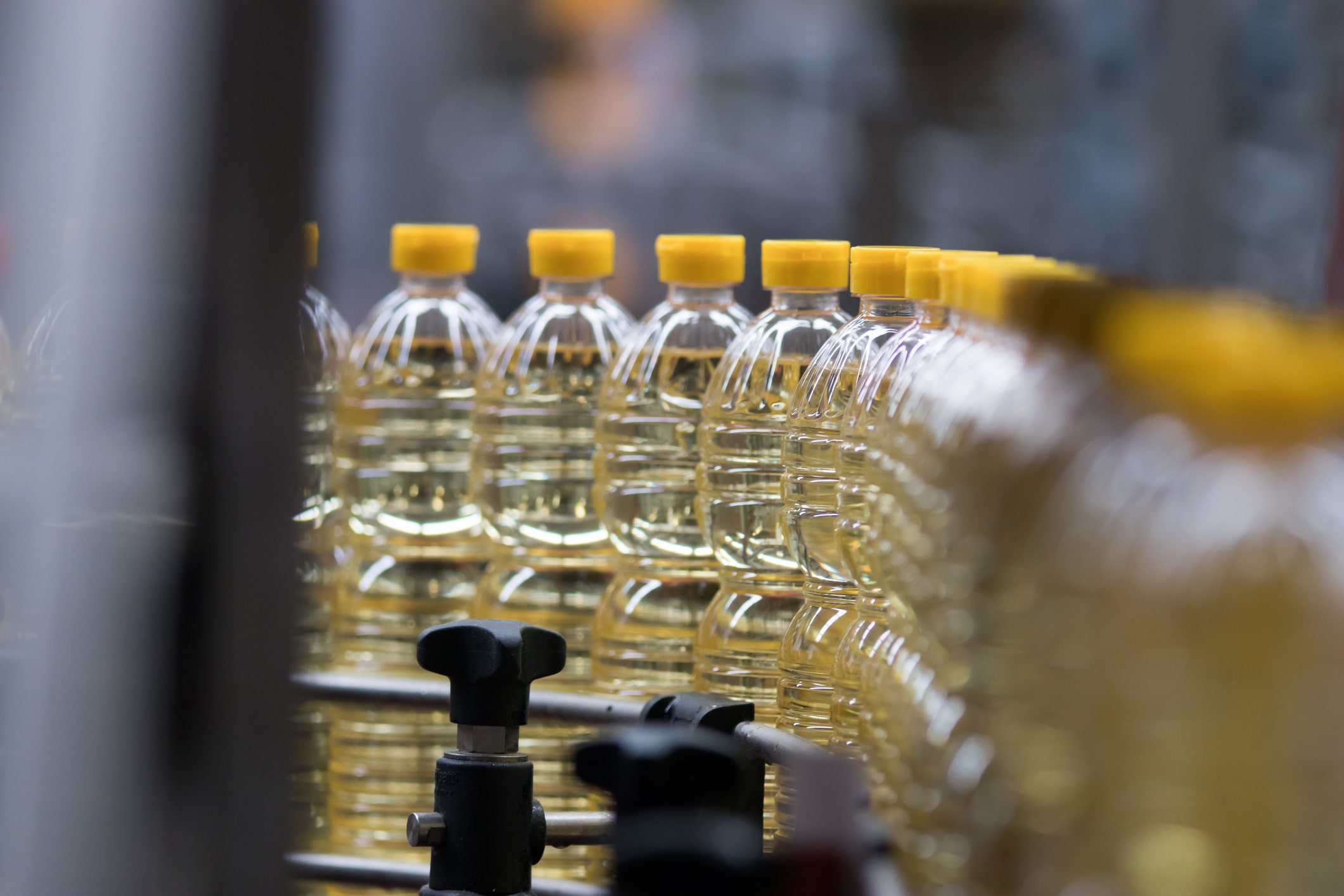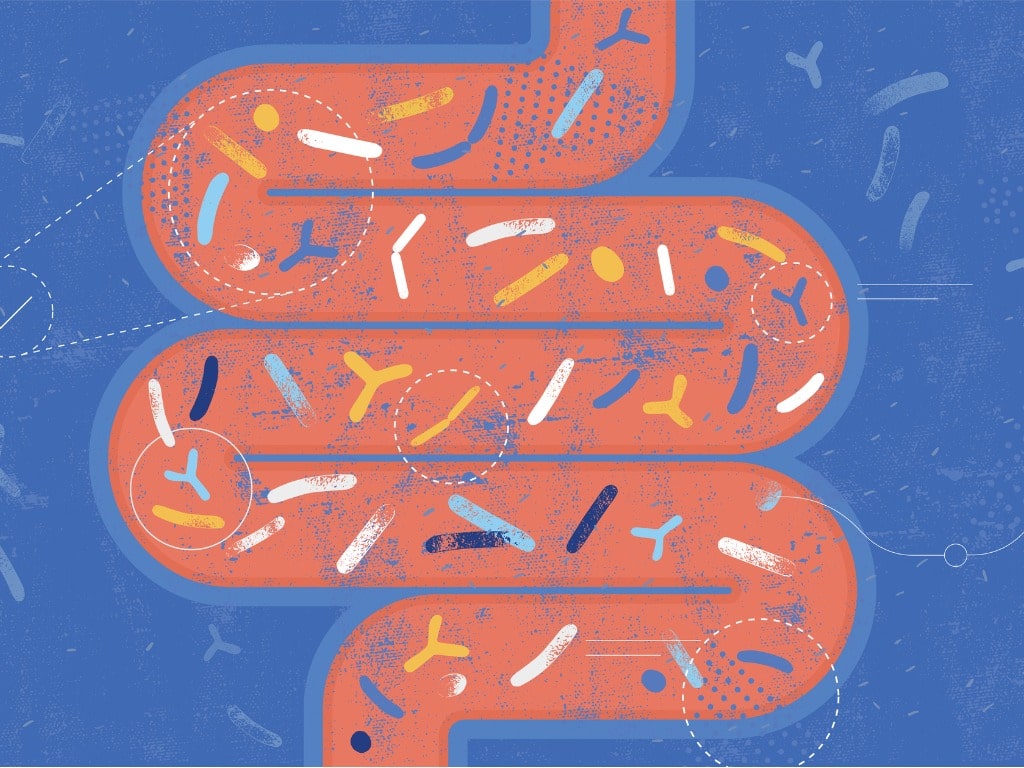Canola oil is used everywhere.
Restaurants use it as “vegetable oil” in much of their cooking.
They might use canola directly, they might use a mix with soybean and corn oils. None of these oils are stable enough under heat for use in cooking, and definitely not for frying.
It has a neutral taste – giving food makers the ability to get the most out of other flavors in food. It’s generally considered to be shelf-stable – allowing packaged foods to sit on shelves longer, travel easier, with less waste and more profits along the way.
Yet, in clear bottles exposed to light and sitting on shelves for months, chances are it’s already unstable before you even have a chance to cook with it.
The quiet alarm with canola oil from a health perspective is that it’s very high in polyunsaturated fats (PUFAs). The structure of PUFAs has chains of carbons with many “kinks” in them. These kinks keep it from solidifying at room temperature and fluid as an oil.
It is also commonly extracted using heat and hexane. While expeller-pressed or cold-pressed techniques address this concern – canola oil is not suitable for storage, and heating, nor does it have the fatty acid profile you want in your system.
The main issue is that the “kinks” (unsaturated bonds) are easily “oxidized”. When oxidized, they need to get rid of molecular energy at all costs – causing damage to any body tissues they come in contact with – like a dangerous game of hot potato or likened to running around with a rusty “oxidized” pair of scissors – some cell or DNA material is eventually going to end up with a burnt hand or a stab wound.
I like to think of an oxidized fat as a ricocheting bullet – bouncing around until it finds an antioxidant system to absorb that energy – causing damage, while also depleting the body of protective systems along the way – injuring cells and making a person more vulnerable to the next threat.
We’re aware of antioxidants from the use of vitamin C, coq10, glutathione, and many buzzwords in the nutrition industry. We forget that the “oxidants” are the things those molecules are looking to absorb and protect us against. The most dangerous oxidants come from not just the metabolic stress of high sugar diets, but the unstable oils used predominantly in American diets.
The more unsaturated a fat is, the more kinks in the chain, and the more likely it is to become oxidized and damaging.
“Poly” means many. “Unsaturated” refers to the vulnerable kinks (double bonds between carbons) in the molecular structure. Polyunsaturated fats (PUFAs), when concentrated into oils and not in their natural amounts in whole food, should not be on the menu!
Why Do We Use Canola Oil?
Canola oil is made from the seed of the rape plant. This is why you will see it on labels as rapeseed oil. Back in the early 1900s, it was used as a mechanical lubricant – the industrial revolution and war machines of WWI and WWII caused an explosion in need.
World War II made it difficult to obtain from Europe and so production in Canada skyrocketed. When war subsided following the end of World War II, the ballooned industry needed to pivot. Could human consumption be the answer?
Rapeseed oil is naturally acidic – containing high levels of erucic acid, making it naturally irritating to humans. Canadian producers responded by breeding “low acid” rape plants. Human use required a type of rape that was low in erucic acid, hence “canola oil” was named in reference to “Canadian oil, low acid”.
With sensitivity to my readers, rapeseed oil is not a great name. It’s fine for industrial use – yet you can see how calling it canola oil is a bit less problematic.
So as in the case of many cultural shifts, the rise of canola oil was from the aftermath of the war effort – a large industry that suddenly lost its demand – that was shifted for seemingly positive benefit – feeding Americans and the world cheaper – and supporting processed shelf-stable food.
Maybe we should call it “war oil” instead – because of its history and the war it’s capable of inflicting on our body tissues. It’s a machine oil that you do not want in your system.
So if this oil is so bad for us, why do so many companies continue to use it? Why has it not been regulated?
Subsidies. Industry profits. International trade.
Over $500 million is spent to influence the farm bill in lobbyists and controlling profit-protecting narratives.
This money is then used to increase the scale of operations to reduce costs and keep margins high.
While there are regulations on how efforts are financed, there are plenty of loopholes that get around them.
Canola oil, despite being produced largely in Canada, can cost 600%+ less than healthier alternatives. Companies have a high interest to protect their ability to use it in food (until they’re forced not to use it) because that cost difference remains pure profit.
The powers that be argue that the increase in costs would be put on the backs of American consumers. Yet, consumers are the same ones backing the subsidies and tax burdens that make it cheap in the first place.
When a frog is put in a pot of water and slowly brought to a boil, the frog doesn’t leap out, it dies. The conversation of subsidies and profit margins is like a pot of water slowly being brought to a boil. It’s hidden. It’s not covered by mainstream news outlets.
Worse, we’re gaslighted to believe it’s healthy for us because it’s “plant-based”.
Like the concept of “inflation”, the world of trade, profits, subsidies, and the farm bill is too complex to understand without some deeper study. Many jobs are involved in the perpetuation of these practices too.
A mainstream news outlet or government department is not going to tell you to get canola oil out of your diet, but I will.
The concept doesn’t have enough Americans jumping out of the pot when the false reality of something they do understand like “cost-saving”, “job-saving” and “plant-based” keeps them in.
For most of the 1980s to early 2010s, the pharmaceutical industry was enamored with the use of statin drugs to control cholesterol. The narrative that cholesterol was bad, animal products were bad, and plant products were good was pushed forward over this time. Producers of vegetable oil jumped on the opportunity to promote their products as an alternative to saturated fat and cholesterol products all the same.
It was always interesting to me that the patents on statin drugs ended in 2012, 30 years following their discovery in 1982 – and the first dietary guidelines released in 2015 (released every 5 years) suddenly discussed cholesterol as “not a nutrient of concern for overconsumption” (page 7 of this report).
Whose interests do these guidelines protect? The answers are always clear in hindsight; yet always made to be murky and controversial in the present.
You were encouraged to switch away from lard (think of grandparents and great grandparents cooking eggs in bacon fat) and to stay away from movie theater popcorn and the “tropical grease” of coconut and palm oils (funded by the vegetable oil industry). You were told to use vegetable oils like soybean, corn, and canola instead. You used margarine as it was believed to be healthier. You were told saturated fat and cholesterol were the ultimate bad guys.
Heart disease remains the leading cause of death. Obesity and diabetes also have skyrocketed. We have had the first generation of Americans that are not expected to outlive the age of their parents.
These were not health initiatives, but marketing initiatives to use these highly subsidized and cheap ingredients – favoring medicine, Big Ag, and Big Food profits while appearing to lower food costs and promote jobs for Americans on the surface.
“Healthy” became synonymous with “vegetarian”. The Food Pyramid became less about health, and more about the government asking what are we funding and producing a lot of that we need to find uses for?
Did you know that Beyond Meat has a stock ticker behind it?
Do you think that the financial and food industries have incentives to promote lab-grown meat or vegetable-sourced patties that taste like meat? Of course, they do.
Unfortunately, while cholesterol can be a marker of inflammation in the body – it’s more of a signal of the body trying to mop up inflammation than it is a cause of it. Cholesterol carries fat to and from the liver for processing, LDL towards it, and HDL away from it.
Blaming the carrier of fat for the health problems is like blaming the smoke for the fire.
When you look at atherosclerotic plaque and cholesterol. The build-up of plaque is comprised of oxidized PUFA’s, not saturated fats. It’s when cholesterol is carrying around unstable fat that it is most dangerous.
When that unstable fat is being carried around in an environment high in metabolic stress (high sugar intake, high stress, high processed foods), it’s a perfect recipe for cardiovascular disease.
What is the biggest source of those PUFAs in the diet? Vegetable oils, where they’re concentrated more unnaturally than what you would receive if you ate soybeans or corn, or sunflower seeds directly. Canola oil is arguably the worst as it contains the highest percentage of PUFAs.
So while the post-World War II pivoting of rapeseed into “Canola” oil was a major factor, the invention of statin drugs, the exploding use of vegetable oils (and the taxes on coconut imports, and the use of domestic taxes for industry subsidies) in my opinion was behind the low-fat, vegetable oil crazy of the 1960s through 2012.
Check out my extended discussion on this timeline: Coconut Oil’s Remarkable Comeback.
Problems with Vegetable Oils like Canola.
- Unstable, heat-sensitive. Prone to becoming “ricocheting bullets” in your body.
- High in omega-6 PUFAs – what your body uses to “make” inflammation.
- Commonly used in restaurants due to low cost – often in fryers. Most commonly comprises a blend of corn, soybean, and canola oil.
- Glyphosate (“Roundup” weed killer) residues may hurt the gut microbiome and bind up nutrients. Genetically modified plants are sprayed with it right before harvest to help dehydrate the plant to boost crop yields. Look for GMO-free and organic food to eliminate exposure. Many processed foods, cereals, and baked goods have detectable levels of glyphosate residues. Drink wines that have been grown in Europe from Spain, France, and Italy where many of these compounds are banned. While some Napa wineries are good – most will be using chemicals you do not want in your system.
- Extracted with the solvent hexane, and often high-heat. Cold-pressed, expeller pressed canola oil is “better”, and slightly more expensive (still less expensive than healthier oils) and while the oil is healthier on the shelf and contains no solvent residue, it is still just as unstable when used for cooking.
It also still contains unwanted PUFAs when used for cooking or in salad dressings, mayonnaise, and marinades. Consumers beware!
Health Implications of Vegetable Oils

Many of the problems with canola oil are also my same concerns with soybean, cottonseed, safflower, sunflower, corn, and other oils. They are all high in PUFAs.
The omega-6 to omega-3 ratio is an important predictor of inflammation in the body. When fewer inflammatory omega-6 fats are available in the system, your body is unable to create inflammation as readily. Omega 3s, from fish, algae, and some nuts and seeds, are naturally anti-inflammatory and promote brain health and help maintain normal levels of metabolic markers like HDL and triglycerides.
To maintain a healthy omega-6:omega-3 ratio, start first by eliminating vegetable oils. This is where most of the magic happens.
Next, support the sufficiency of omega-3 fats with 1000-2000g per day of EPA, DHA, and DPA-containing fish oil. I personally carry Omega Complete by Doctor Alex Supplements and take 1-2 softgels per day with food unless I plan to eat a wild-caught omega-3 rich fish like salmon that day.
Dietary Fats Become Part of You
”You are what you eat” is a mantra we are all familiar with. When you eat fat, it literally becomes “you”. It becomes part of every cell in the body – especially the make-up of the brain and nerves that are largely made up of fat. Every cell membrane in your body contains fat. When you eat sugar, there are ways to burn it off before excess is turned into fat.
When you eat omega-6 fats and they become “you”, it takes almost 2 years to replace 50% of them with new fats, known as the “half-life”. With a nearly 2-year half-life, omega-6 oils take 2-8 years to be replaced in the body with healthier fats – assuming you’re eating healthier fats in your diet.
The time to start is now! The benefits start with today’s fat intake.
Action Steps to Counteract Vegetable Oils in the Diet:
The brain is made mostly of fat, if you have concerns about dementia, Alzheimer’s, Parkinson’s, and general trouble focusing and learning – start with an oil change!
- Use stable oils for cooking, and while some oils are not good for cooking, they can be used on salads or to dress vegetables once already cooked. Download my free guide to learn which oils should be used for what, and what should be avoided altogether.
- Take 1000-2000mg of high-quality fish oil like Omega Complete by Doctor Alex Supplements. Many brands offer high purity and quality dosages. If you’re burping up a fishy taste, chances are it’s a poor brand. Check with your doctor if you take blood-thinning medication.
Vegetarians may consider Algal oil (vegan omega-3), as well as freshly ground flax and chia seeds, and nuts like walnuts. Keep in mind that genetics may mean that your body cannot convert plant sources of omega-3 (alpha-linolenic acid “ALA”) into the DHA, EPA, and DPA that the body uses. These are essential fats that the body does not make on its own.
We require dietary or supplemental intake. I respect moral, environmental, and religious beliefs and that is everyone’s right. Some do make moral and religious exceptions in the name of health.
My personal and professional bias is that we need sources of EPA, DHA, and DPA in the diet because not everyone can convert plant sources efficiently in line with the body’s needs for optimal function. You can still make personal choices that fall in line with your beliefs and morals. - Eat wild-caught fish like salmon 1-2 times per week. Breaded and fried fish is no longer on the menu. If you do not like fish, omega-3 supplementation is increasingly important.
- Eat pasture-raised, grass-fed, AND grass/pasture-finished meat and poultry. Others are fed grains to fatten them up and increase marbling in the meat – which is why grass-finished is just as important as grass-fed.
It makes you wonder whether the high intake of grains in American diets has anything to do with our alarming overweight and obesity rates… Might we have extra marbling in our muscles because of it?
Eggs should have a bright, orange-colored yolk and a strong shell (not the dull, yellow color and fragile, rubbery shell you may be accustomed to). - Not all omega-6 fats are evil. Gamma linoleic acid or GLA has healthy benefits for the body. Evening primrose, borage, and black currant oils contain high levels of GLA that can be beneficial in addition to omega-3 intake.
- Avoid charring and frying food even while using healthy oils. The charring process creates irritating and sticky compounds that are pro-aging and tax the body’s antioxidant and detoxification systems.
Rotisserie cooking, sous vide, and air-frying are better cooking methods although not entirely perfect. “Low and slow” techniques are best. Be mindful of sugary marinades that may also use vegetable oils.
I like to take Daily Phyto Balance 20 minutes prior to a meal that has any charring for added support. - Check labels for canola oil or rapeseed oil, and the other common vegetable oils like sunflower, safflower, corn, cottonseed, and soy. You’ll quickly notice that they show up EVERYWHERE.
Mayonnaise makers may market “avocado oil” or “olive oil” on the jar, yet canola oil or soybean oil still make up the majority of the oil used. Salad dressings, condiments, and anything in a package with an ingredient list bigger than your thumb can cover are likely to contain these oils.
I like Primal Kitchen’s mayonnaise (save 10% with code “dralex”) and salad dressings the best to avoid unwanted ingredients and fillers. You can also make your own and control the ingredients yourself.
Most potato chip brands will use safflower and/or sunflower oil. Look for avocado and coconut oil. Homemade sweet potato and regular potato chips can be quite tasty. At home, I’ll slice potatoes thin with a mandolin slicer and cook with duck fat for even more flavor. For sweet potatoes, I might add cinnamon and salt.
For regular russet potatoes, I might use rosemary, black pepper, salt, and cut-thin onions on top that have a nice flavor when roasted. I’ll use the same strategy for beet or turnip chips. For a more neutral oil flavor or vegetarian option, use avocado oil or expeller-pressed coconut oil that will minimize any coconut flavor.
This “health-washing” of labels is very common. They don’t care. They want higher profit margins. They will gladly accept your money. They like and control government support and guidelines. Don’t fall prey to it. The health-washing doesn’t stop with oils.
Now equipped with the right information, you can choose differently.
Which Oil Should I Cook With?
Related Articles:
- Can Elevated LDLs Be a Protective Mechanism in Response to Inflammation and Leaky Gut?
- Arterosil Benefits – Support for Cardiovascular Health
- Is Saturated Fat Healthy?
- Why Does Heart Disease Run in My Family?
- Do You Have Hidden Heart Disease?
- Support HDL Cholesterol Levels Naturally and Keep a Healthy Heart




